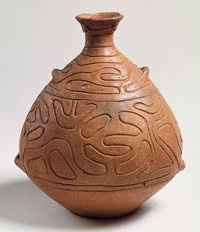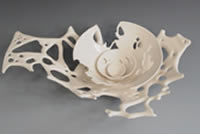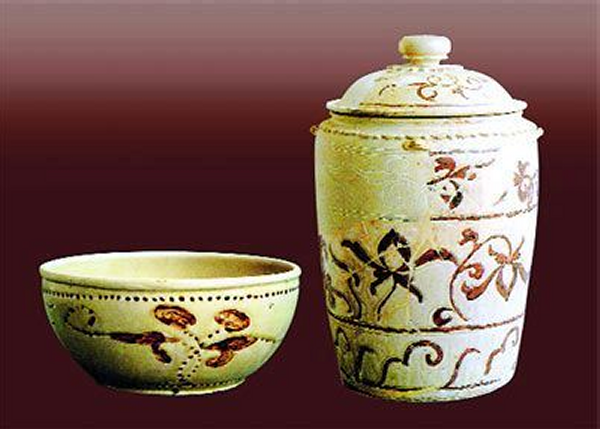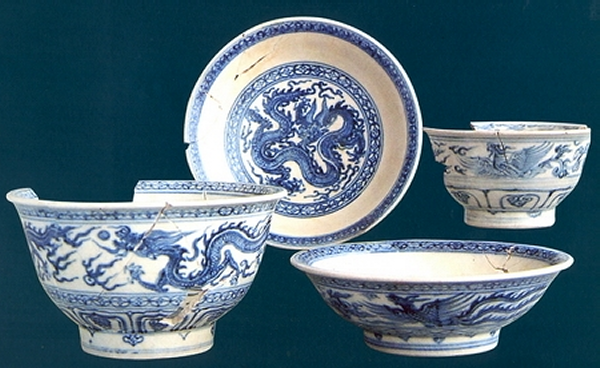
Four Island Plate, Vietnam, Lê Dynasty,16th century. Courtesy Zetterquist Galleries
Large Blue and White Barbed Rim Plate with underglaze cobalt blue depiction of four islands in the sea, surrounded by a band of petal designs and the cavetto of the bowl covered in large lotus petal depictions with beautifully painted ruyi patterns within. The mouth rim is decorated with another band of cloud decoration. Diameter: 32.5cm. Areas of rim fritting.
Published in “Vietnamese Ceramics: A Separate Tradition” by John Stevenson and John Guy, 1997. Plate 244.
The John Menke Collection of Vietnamese Ceramics will be on view atZetterquist Galleries, 3 East 66th Street, Suite 1B. The encyclopedic collection from the Dong Son Culture (700-43 B.C.) through the 17th century was assembled over more than 40 years by the eminent scientist, John Menke. Zetterquist Galleries has selected more than 50 pieces for their historical importance and beauty and will offer a rare opportunity to view together 17 centuries of the Vietnamese ceramic tradition. Many of the works in this exhibition have been published in major Vietnamese ceramics books in the U.S. and Europe over the last two decades.
For over forty years, the eminent scientist John Menke assembled an encyclopedic collection of Vietnamese ceramics from the Dong Son culture (700 – 43 B.C.) through the seventeenth century. More than fifty pieces were chosen for their historical importance and beauty, and they offer a rare opportunity to view seventeen centuries of the Vietnamese ceramic tradition in one group. Many of the works in this exhibition have been published in major Vietnamese ceramics books in the United States and Europe over the last two decades. The earliest pieces are earthenware vessels, some simple in their functional form, others crafted after bronze vessel shapes. The most notable from this group is a Dong Son tripod jar with handle and impressed decoration containing original red paint.

Dong Son Culture Tripod Vessel with Handle, incised pattern encrusted with red pigment. Courtesy Zetterquist Galleries
Excellent condition. Height: 20cm

Early Cham Jar, brown stoneware with natural ash glaze and incised design and applied handles. Courtesy Zetterquist Galleries
Height: 18cm

Large brown and gold ewer with elephant trunk shaped spout, Funan-Chenla Culture, 6th – 8th c. A.D. Courtesy Zetterquist Galleries
height 31cm, some repair to mouth rim,
Provenance: Jochen May Collection, Germany
The Gioa-Chi period (44 – 544 A.D.) pieces are closely related to Chinese bronze-influenced ceramic pieces from the Han Dynasty, and they include large and important vessels of various forms, including a funerary container in the shape of a house. A large covered Hu-form jar best illustrates the direct connection Vietnam had with China during this period while retaining its own national character.

Model of Granary, hard earthenware with incised details, In two pieces with lid as roof, Giao Chi Period from Thanh Hoa area, Courtesy Zetterquist Galleries
Height: 20.5cm Length: 29cm. TL tested. Excellent condition.
Provenance: Jochen May Collection, Germany
Published in Verborgene Schatz; 2000 Jahre Vietnamesische Keramic, pl. 22.

Straw Glazed Hu Shaped Jar with cover, Giao Chi Period, Incised decoration and applied handles, Courtesy Zetterquist Galleries
Height: 34cm, Repair to base,
Provenance: Jochen May Collection, Germany

Hu Shaped Ewer with Elephant Head Spout and Totie Mask on Shoulder, buff colored stoneware, Giao Chi Period, Courtesy Zetterquist GalleriesCourtesy Zetterquist Galleries
Height: 27cm, with repair to spout and handle restored.
Provenance: Jochen May Collection, Germany,
Published in Verborgene Schatz; 2000 Jahre Vietnamesische Keramic

Straw Glazed Vase, Giao Chi Period, hard earthenware with incised design and applied handles. Courtesy Zetterquist Galleries
24cm high, with repaired cracks and chips.
Provenance: Jochen May Collection, Germany

.Tripod Tray with Green Splashes and Incised Design, Giao Chi Period, Courtesy Zetterquist Galleries
Diameter: 23cm, some repair to rim and touch-up to green glaze.
Provenance: Jochen May Collection, Germany

Circular Stoneware Box with Lid, abraded brown glaze, Giao Chi Period, Courtesy Zetterquist Galleries
good condition, Height: 9cm,
Provenance: Jochen May Collection, Germany
Thanh Hoa type ceramics, produced from the eleventh through thirteenth centuries, are unique in Asian ceramics, as they represent cultural influences both from India and China. Using advanced firing and glazing techniques from China, their forms were often influenced by Indian bronzes, sometimes filtered through Cambodian works, brought up through the southern trade routes. Several different Thanh Hoa forms and types are represented in this collection, the most prominent of which is a magnificent lobed jar with its original lid and reticulated foot, all highlighted by iron-oxide brown details.

Large Thanh Hoa Jar with Lid. Lobed body with brown decorative highlights and standing on a reticulated pedestal base. Ly Dynasty. Courtesy Zetterquist Galleries
Height: 38cm. Good condition with some areas of glaze ware and repaired cracks on lid.

Lion Shaped Base for Lamp or Censer, straw glazed stoneware, found in Hai Duong, Ly Dynasty, Courtesy Zetterquist GalleriesCourtesy Zetterquist Galleries
Height: 15.5cm, some repair to face, chips and glaze flaking,
Provenance: Jochen May Collection, Germany,
Published in Verborgene Schatz; 2000 Jahre Vietnamesische Keramic, pl.31.

Bell-shaped Thanh Hoa Jar with Brown Floral Decoration. Ly Dynasty. Courtesy Zetterquist Galleries
Height: 21cm. Good Condition.

Thanh Hoa Bowl with Brown Dots. Ly Dynasty. Courtesy Zetterquist Galleries
DIa. 18cm. Good Condition
Provenance: Jochen May Collection, Germany
Thanh Hoa Basin with Brown Floral Decoration. Ly Dynasty.
Diameter: 19.5cm. Good condition

Small Thanh Hoa Ewer and Cover, clear crackled glaze over white stoneware body. Ly Dynasty. Courtesy Zetterquist Galleries
Height with lid: 12cm. Discolored and areas of glaze flaking.
Published in “Vietnamese Ceramics: A Separate Tradition” by John Stevenson and John Guy, 1997. Plate 54
Small Thanh Hoa bottle vase with clear glaze over white stoneware body. Ly Dynasty.
Height: 13.5cm. Chip on mouth-rim.
Small Thanh Hoa Jar. Clear glaze over white stoneware. Ly Dynasty.
Height: 5.5cm. Good condition
Provenance: Jochen May Collection, Germany
The thirteenth through fifteenth centuries saw a flourishing of ceramic production influenced by Chinese Song and Yuan Dynasty wares. In the Menke collection, there are several forms and glaze types represented, including Qingbai-type wares, green celadons, brown wares and creamy white wares. One of the most important of these is a large white-ware jar with raised floral decoration scrolling around its body.

Qingbai – style bowl with molded floral decoration and a finely crackled translucent glaze. Trân Dynasty. Courtesy Zetterquist Galleries
Diameter: 22.5cm . Good condition.
Provenance: Jochen May Collection, Germany

White-ware bowl with molded Ruyi petal pattern and translucent glaze. Ly Dynasty. Courtesy Zetterquist Galleries
Diameter: 18.5cm. Some rim fritting and small hairline cracks emanating from rim.
Provenance: Jochen May Collection, Germany
White-ware bowl with molded petal pattern encasing Buddhist symbols under a finely crackled glaze. Ly Dynasty.
Diameter: 19cm. Some rim chips and heavy discoloration of glaze.
Provenance: Jochen May Collection, Germany

Brown Jar with original lid and incised lines around the globular body. Trân Dynasty. Courtesy Zetterquist Galleries
There are also applied fish in relief around the lid and set within a double raised band around the shoulder. Height: 28cm.
Provenance: Jochen May Collection, Germany.

Brown Jar with cover and incised line-pattern. Trân Dynasty. Courtesy Zetterquist Galleries
Height: 23cm. Good condition.
Provenance: Jochen May Collection, Germany.
Brown Jar with cover and incised line-pattern. Trân Dynasty. Courtesy Zetterquist Galleries
Height: 23cm. Good condition.
Provenance: Jochen May Collection, Germany.
In the fifteenth century, the Chinese stopped exporting their porcelain, and Vietnam became one of the most important exporters of blue and white and enameled porcelains in the world. There are fifteen examples of fine Vietnamese blue and white porcelains from the fifteenth and sixteenth centuries, including a variety of forms and decoration. They are delicately and joyfully painted with birds, fish, dragons, landscapes and floral motifs. The most important piece in the collection is a large barb-rimmed plate depicting four islands in a seascape surrounded by three bands of lotus, wave and cloud decoration.

Blue and White plate with two birds flying in around eachother surrounded by various flora. Lê Dynasty. Courtesy Zetterquist Galleries
Diameter 23.5cm. Good condition.

Blue and White Bird Plate with depiction of a single bird and trees. Lê Dynasty. Courtesy Zetterquist Galleries
Diameter: 23.5cm. Some rim chips.

Blue and White Fish Plate with fanciful depiction of flounder like fish with extravagant fins swimming amongst water plants. Lê Dynasty. Courtesy Zetterquist Galleries
Diameter: 22.5cm. Good condition.
Published in: “Vietnamese Ceramics: A Separate Tradition” by John Stevenson and John Guy, 1997. Plate 275.

Blue and White Fish Plate with single fish swimming among water plants, set within a band of scrolling lotus. Lê Dynasty. Courtesy Zetterquist Galleries
Diameter: 23.8cm. Two hairline cracks.

Large blue and white jar with green detailing of fish swimming amongst lotus plants. Lê Dynasty. Courtesy Zetterquist Galleries
Approximate Height: 22cm. Minor mouth rim chips.
Published in “Vietnamese Ceramics: A Separate Tradition” by John Stevenson and John Guy, 1997. Plate 533.

Large blue and white jar with green detailing of fish swimming amongst lotus plants. Lê Dynasty. Courtesy Zetterquist Galleries
Approximate Height: 22cm. Minor mouth rim chips.
Published in “Vietnamese Ceramics: A Separate Tradition” by John Stevenson and John Guy, 1997. Plate 533.

A group of five small covered porcelain boxes ant two miniature jars. Lê Dynasty. Courtesy Zetterquist Galleries
Three of the five boxes and the two jars are decorated with cobalt blue floral and landscape decorations. The largest of the boxes is pure white and one of the boxes has polychrome accents (red retouched). Diameters:3cm – 8.5cm All in good condition
Finally, the seventeenth century is represented by a fine altarpiece with an elaborately modeled beast supporting a candle holder with an attendant rectangular censor.

Altar pieces consisting of a large candle holder in the form of a mythical beast sitting on a plinth with a tall squared pedestal resting on its back. Late Lê Dynasty, 17th century. Courtesy Zetterquist Galleries
The top of the pedestal is surmounted by a rectangular platform with elaborately carved protrusions surrounding a round candle receptacle. Covered in a straw colored glaze with dark green highlights. Repair to beasts tail and mane, and also to the extremities at the top. Crack to base..Altar pieces consisting of a large candle holder in the form of a mythical beast sitting on a plinth with a tall squared pedestal resting on its back. The top of the pedestal is surmounted by a rectangular platform with elaborately carved protrusions surrounding a round candle receptacle. Covered in a straw colored glaze with dark green highlights. Repair to beasts tail and mane, and also to the extremities at the top. Crack to base..
The attendant censer is in the style of bronze pieces of the era and sits on a reticulated pedestal base and shares many of the decorative elements of the candle-holder. Heights: 48.2cm and 16.3cm. Chips and breaks to minor appendages, two back legs broken and missing.
 Ceramics and pottery are used interchangeably ay times, which is not a problem as there is little difference among the words. The words both refer to an art form which shapes and molds clay. However, technically speaking, the word ceramics is a more general term and it includes the term pottery.
Ceramics and pottery are used interchangeably ay times, which is not a problem as there is little difference among the words. The words both refer to an art form which shapes and molds clay. However, technically speaking, the word ceramics is a more general term and it includes the term pottery.









































